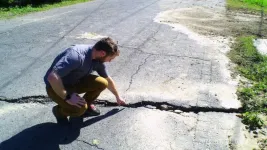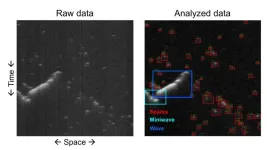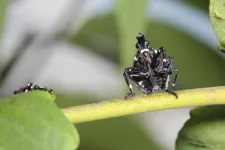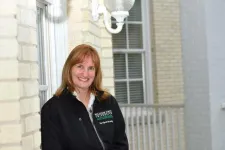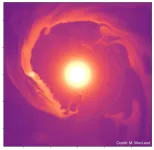(Press-News.org) For more than 30 years, the models that researchers and government agencies use to forecast earthquake aftershocks have remained largely unchanged. While these older models work well with limited data, they struggle with the huge seismology datasets that are now available.
To address this limitation, a team of researchers at the University of California, Santa Cruz and the Technical University of Munich created a new model that uses deep learning to forecast aftershocks: the Recurrent Earthquake foreCAST (RECAST). In a paper published today in Geophysical Research Letters, the scientists show how the deep learning model is more flexible and scalable than the earthquake forecasting models currently used.
The new model outperformed the current model, known as the Epidemic Type Aftershock Sequence (ETAS) model, for earthquake catalogs of about 10,000 events and greater.
“The ETAS model approach was designed for the observations that we had in the 80s and 90s when we were trying to build reliable forecasts based on very few observations,” said Kelian Dascher-Cousineau, the lead author of the paper who recently completed his PhD at UC Santa Cruz. “It’s a very different landscape today.” Now, with more sensitive equipment and larger data storage capabilities, earthquake catalogs are much larger and more detailed
“We’ve started to have million-earthquake catalogs, and the old model simply couldn’t handle that amount of data,” said Emily Brodsky, a professor of earth and planetary sciences at UC Santa Cruz and co-author on the paper. In fact, one of the main challenges of the study was not designing the new RECAST model itself but getting the older ETAS model to work on huge data sets in order to compare the two.
“The ETAS model is kind of brittle, and it has a lot of very subtle and finicky ways in which it can fail,” said Dascher-Cousineau. “So, we spent a lot of time making sure we weren’t messing up our benchmark compared to actual model development.”
To continue applying deep learning models to aftershock forecasting, Dascher-Cousineau says the field needs a better system for benchmarking. In order to demonstrate the capabilities of the RECAST model, the group first used an ETAS model to simulate an earthquake catalog. After working with the synthetic data, the researchers tested the RECAST model using real data from the Southern California earthquake catalog.
They found that the RECAST model — which can, essentially, learn how to learn — performed slightly better than the ETAS model at forecasting aftershocks, particularly as the amount of data increased. The computational effort and time were also significantly better for larger catalogs.
This is not the first time scientists have tried using machine learning to forecast earthquakes, but until recently, the technology was not quite ready, said Dascher-Cousineau. New advances in machine learning make the RECAST model more accurate and easily adaptable to different earthquake catalogs.
The model’s flexibility could open up new possibilities for earthquake forecasting. With the ability to adapt to large amounts of new data, models that use deep learning could potentially incorporate information from multiple regions at once to make better forecasts about poorly studied areas.
“We might be able to train on New Zealand, Japan, California and have a model that's actually quite good for forecasting somewhere where the data might not be as abundant,” said Dascher-Cousineau.
Using deep-learning models will also eventually allow researchers to expand the type of data they use to forecast seismicity.
“We’re recording ground motion all the time,” said Brodsky. “So the next level is to actually use all of that information, not worry about whether we’re calling it an earthquake or not an earthquake but to use everything."
In the meantime, the researchers hope the model sparks discussions about the possibilities of the new technology.
“It has all of this potential associated with it,” said Dascher-Cousineau. “Because it is designed that way.”
END
Seismologists use deep learning for improved earthquake forecasting
2023-09-02
ELSE PRESS RELEASES FROM THIS DATE:
Software developed at UC Davis analyzes calcium ‘sparks’ that can contribute to arrhythmia
2023-09-01
(SACRAMENTO, Calif.) — A team of UC Davis and University of Oxford researchers have developed an innovative tool: SparkMaster 2. The open-source software allows scientists to analyze normal and abnormal calcium signals in cells automatically.
Calcium is a key signaling molecule in all cells, including muscles like the heart. The new software enables the automatic analysis of distinct patterns of calcium release in cells. This includes calcium "sparks," microscopic releases of calcium within cardiac cells associated ...
Could insights from ants help people build better transportation networks?
2023-09-01
Key takeaways
Ants can either forage for food as individuals or recruit other members of their colonies to help search for or carry food back to their nests.
UCLA biologists found that the strategies ants use to forage play a bigger role in how they build their nests than innate, evolutionary “blueprints” do.
When building nests, ants strike a balance between transportation efficiency and architectural constraints. Researchers say that observation could help humans design more efficient transportation systems tailored to specific needs.
Could ants’ nests hold the secret to reducing traffic congestion on the 405 Freeway?
In a new study, UCLA biologists ...
Invasive spotted lanternfly may not damage hardwood trees as previously thought
2023-09-01
UNIVERSITY PARK, Pa. — In 2012, when the spotted lanternfly (Lycorma delicatula) arrived in the U.S. from its home in China, scientists, land managers, and growers were understandably concerned that the sap-feeding insect would damage native and commercial trees. New long-term research led by Penn State has discovered that hardwood trees, such as maple, willow and birch, may be less vulnerable than initially thought.
“Since the lanternfly was first introduced to the northeastern U.S., the question has been, ‘How at-risk are our forests?’ said Kelli Hoover, professor of entomology at Penn State. “So far, we haven't had a good answer. Our study is the first ...
$26M NIH grant addresses environmental influences on child health
2023-09-01
EAST LANSING, Mich. – Backed by a $26 million federal grant, researchers at three Michigan universities, a leading health care system, and a state agency will continue a long-term study of how exposure to environmental factors during pregnancy and early childhood can impact health for a lifetime.
The funding from the National Institutes of Health, or NIH, is for the second phase of a national research program called ECHO, which stands for the Environmental Influences on Child Health Outcomes, and includes a sample of mothers, infants and children from across the United States. The first phase began in 2016.
“This award shows the research ...
LDL not the be all, end all in heart disease, heart attacks and stroke
2023-09-01
Milwaukee, Wis. – Sept. 1, 2023 – Despite advances in treatment for high cholesterol, heart disease remains the leading cause of death in the U.S. Scientists at the Medical College of Wisconsin (MCW) are investigating the role of a form of cholesterol called very-low-density lipoprotein – and their findings may lead to new treatment options in the future.
The research team is led by Ze Zheng, MBBS, PhD, MCW assistant professor of medicine (endocrinology and molecular medicine); co-leader of the MCW Cardiovascular Center’s Atherosclerosis, Thrombosis ...
Hot Jupiter blows its top
2023-09-01
A planet about 950 light years from Earth could be the Looney Tunes’ Yosemite Sam equivalent of planets, blowing its atmospheric ‘top’ in spectacular fashion.
The planet called HAT-P-32b is losing so much of its atmospheric helium that the trailing gas tails are among the largest structures yet known of an exoplanet, a planet outside our solar system, according to observations by astronomers.
Three-dimensional (3D) simulations on the Stampede2 supercomputer of the Texas Advanced Computing Center (TACC) helped model the flow of the planet’s atmosphere, ...
Kidder receives American Chemical Society’s 2023 Mid-Career Award
2023-09-01
Michelle Kidder, a senior R&D staff scientist at the Department of Energy’s Oak Ridge National Laboratory, has received the American Chemical Society’s Energy and Fuels Division’s Mid-Career Award for sustained and distinguished contributions to the field of energy and fuel chemistry. She was recognized for her scientific community service, leadership and contributions. Her research focuses on novel material development, methods and advanced characterizations for the separation and reaction chemistry of renewable energy resources including lignin and carbon dioxide.
Kidder, ...
Mukherjee elevated to senior member of IEEE
2023-09-01
Subho Mukherjee, an R&D associate in the Vehicle Power Electronics Research group at the Department of Energy’s Oak Ridge National Laboratory, has been elevated to the grade of senior member of the Institute of Electrical and Electronics Engineers, or IEEE. Senior IEEE members have made significant contributions to the profession and worked in the engineering field for 10 years or more.
As an electrical engineer, Mukherjee focuses on wireless power charging and developing wide bandgap semiconductor-based ...
SMART-BARN – a cutting-edge technology lab to study animal groups
2023-09-01
Researchers from the Cluster of Excellence Centre for the Advanced Study of Collective Behaviour (CASCB) and the Max Planck Institute of Animal Behavior have converted a former barn into a cutting-edge technology lab for complex behavioral analysis. In it, they can now study the intricate behaviour of animal groups. The barn also served as a prototype for the largest swarm behaviour lab at the University of Konstanz: the Imaging Hangar.
A major limitation in behavioural research is that scientists can either study animals under highly-controlled, yet often unrealistically simplified and ...
Immune cells shape their own path
2023-09-01
When fighting disease, our immune cells need to reach their target quickly. Researchers at the Institute of Science and Technology Austria (ISTA) now discovered that immune cells actively generate their own guidance system to navigate through complex environments. This challenges earlier notions about these movements. The researchers’ findings, published in the journal Science Immunology, enhance our knowledge of the immune system and offer potential new approaches to improve human immune ...
